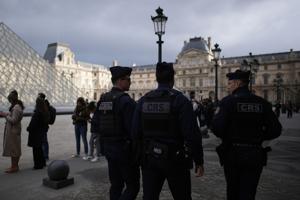
Two suspects in the dramatic jewel heist at the Louvre Museum have “partially” acknowledged their involvement, according to Paris Prosecutor Laure Beccuau. The suspects are believed to have been the individuals who unlawfully entered the renowned museum on October 19, 2023, stealing jewels valued at approximately €88 million ($102 million).
During a news conference held on Wednesday, Beccuau announced that both men face preliminary charges of theft committed by an organized gang and criminal conspiracy. They are expected to be placed in provisional detention as investigations continue. Specific details regarding their admissions were not disclosed.
The audacious theft unfolded in less than eight minutes, with the thieves forcing open a window and using power tools to cut through display cases. They fled with eight pieces of the French crown jewels, leaving authorities in shock.
One suspect, a 34-year-old Algerian national, was apprehended at Charles de Gaulle Airport on Saturday night while attempting to board a flight to Algeria without a return ticket. Beccuau noted that this individual had resided in France since 2010 and was primarily known to law enforcement for minor traffic offenses. The second suspect, aged 39, was taken into custody at his home in the northern suburb of Aubervilliers. Beccuau stated that there was no indication he intended to leave the country, although he had a history of thefts. DNA evidence linked him to the scene, as it was found on one of the glass cases and on items left behind by the thieves.
As the investigation progresses, the jewels remain missing. Beccuau emphasized the difficulty in selling such high-profile stolen items, warning that anyone attempting to do so would be guilty of concealing stolen goods. She urged those with information to return the jewels, stating, “It’s still time to give them back.”
Security Concerns and System Failures
The heist has sparked significant scrutiny over the Louvre’s security measures. Paris Police Chief Patrice Faure addressed Senate lawmakers, revealing substantial deficiencies in the museum’s security systems. He pointed out that outdated technology and inadequate upgrades have left vulnerabilities in the museum’s defenses.
Faure described that portions of the museum’s video surveillance network remain analog, resulting in lower-quality images that are not shared in real-time. A long-awaited upgrade, estimated at $93 million, is not expected to be completed until 2029-2030. Furthermore, Faure disclosed that the Louvre’s authorization to operate its security cameras expired in July and had not been renewed, highlighting a lapse in administrative oversight.
Despite the rapid response from police following the theft, Faure indicated that the delay was evident earlier in the alert chain, from the initial detection to museum security and the emergency response. Notably, the first alert to police came from a cyclist outside the museum, rather than the museum’s alarm systems.
Insurance and Cultural Impact
The theft also revealed a significant insurance gap, as the French state self-insures its national museums due to the exorbitant costs of private insurance for priceless heritage items. Consequently, the Louvre will not receive any compensation for the loss of the jewels, compounding the financial and cultural ramifications of the heist.
Faure rejected proposals for a permanent police presence inside the museum, arguing that it would not effectively deter fast-moving criminals. Instead, he emphasized the need for a quicker alert process and called for legislative changes to authorize advanced tools, such as AI-based anomaly detection, to improve security response times.
The theft has prompted a broader discussion about the vulnerabilities of cultural institutions in France. Rachida Dati, the Culture Minister, has faced mounting pressure to address these issues while refusing to accept the resignation of the Louvre’s director. Although she acknowledged existing security gaps, Dati maintains that the museum’s alarm systems were operational.
The repercussions of this incident extend beyond immediate security concerns. The Louvre, already facing challenges due to mass tourism and staff shortages, experienced a spontaneous strike by employees in June over working conditions. Unions have pointed out that the layout of the museum creates blind spots that can be exploited by thieves.
As the investigation continues and authorities seek to enhance security, experts fear the stolen items may have already been dismantled or altered to erase their identities. The cultural significance of the jewels and the implications for museum security remain at the forefront of discussions following this high-profile heist.






